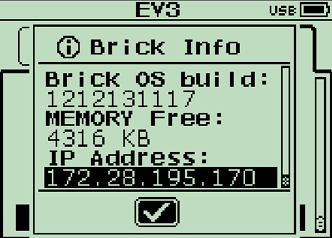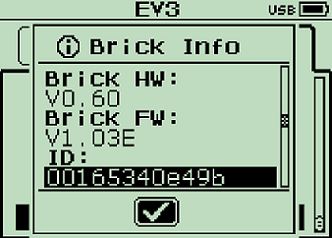Getting Started with MATLAB Support Package for LEGO MINDSTORMS EV3 Hardware
This example shows you how to set up communications with the EV3 brick.
Introduction
The MATLAB® Support Package for LEGO® MINDSTORMS® EV3 Hardware enables you to interact with LEGO MINDSTORMS EV3 hardware from within MATLAB.
This example shows you how to set up communications with the EV3 brick over a USB, Wi-Fi®, or Bluetooth® connection. Then, verify that you can use MATLAB commands to interact with the EV3 hardware by playing a tone from speaker on the EV3.
Prerequisites
If you are new to MATLAB, we recommend completing the Interactive MATLAB Tutorial, Get Started with MATLAB, and running the Getting Started with MATLAB example.
Required Hardware
You will need the following hardware:
EV3 Brick
EV3 USB Cable, or EV3 WiFi Dongle, or Bluetooth Dongle for Host Computer (optional, if no built-in Bluetooth available on your computer)
Task 1 - Set Up LEGO MINDSTORMS EV3 Communication
Set up communications with the EV3 brick using one of the following options.
Option 1: USB
1. Use the USB cable to connect the Mini-USB port on the EV3, labelled 'PC', and USB port on your host computer.
Option 2: WiFi
1. Plug EV3 WiFi Dongle into EV3 Host USB Port, labelled 'USB'.
2. In the EV3 Brick Interface, use Settings > WiFi and enable WiFi. Then, search for and connect to a network. For more information, consult the EV3 User Guide.
3. Then, using Settings > Brick Info, get the IP Address and hardware ID. Make a note of these two values for use later on.


4. To verify that the EV3 brick is reachable, use the command line on your host computer to ping the IP address of the EV3 brick. For example, enter:
ping 192.28.195.170
The ping statistics indicate whether the EV3 brick is reachable from your host computer.
Option 3: Bluetooth
1. Enable Bluetooth on your host computer. If it does not have built-in Bluetooth, use a Bluetooth dongle.
2. In the EV3 Brick Interface, select Settings > Bluetooth and enable Bluetooth.
3. Pair the host computer and EV3 brick. On the host computer, get the number of the serial port for the Bluetooth dongle. Make a note of the name for use later on.
Task 2 - Create a Connection to the EV3 Brick
Create a connection to the EV3 brick called mylego using one of the following options.
Option 1: USB
mylego = legoev3('usb')Option 2: WiFi
mylego = legoev3('wifi',<IP_Address>,<Hardware_ID>)Enter the IP Address and hardware ID you wrote down during Task 1.
For example:
mylego = legoev3('wifi','192.168.1.3','00165340e49b')Option 3: Bluetooth
mylego = legoev3('bluetooth',<Serial_Port>)Use the serial port name found in Task 1.
For example:
mylego = legoev3('bluetooth','COM3')Option 4: Reconnect Using Settings from the Last Successful Connection
If you use legoev3 with no arguments, legoev3 reuses the settings from the last successful connection to an EV3 brick. This is the most effective way to reconnect to a device.
mylego = legoev3
Task 3 - Beep EV3 Brick
Verify that the connection works. Use the mylego connection from Task 2 to play a beep sound from the speaker on the EV3 brick.
beep(mylego)
Task 4 - Terminate Communication
To terminate the connection, clear the legoev3 object.
clear mylego
Summary
This example showed you how to set up communications with the EV3 brick over a USB, WiFi, or Bluetooth connection. It also showed you how to use a MATLAB command to connect to and interact with the EV3 brick. For more information, see Interact with EV3 Brick Peripherals, Read Sensor Values, and Control Motors example.